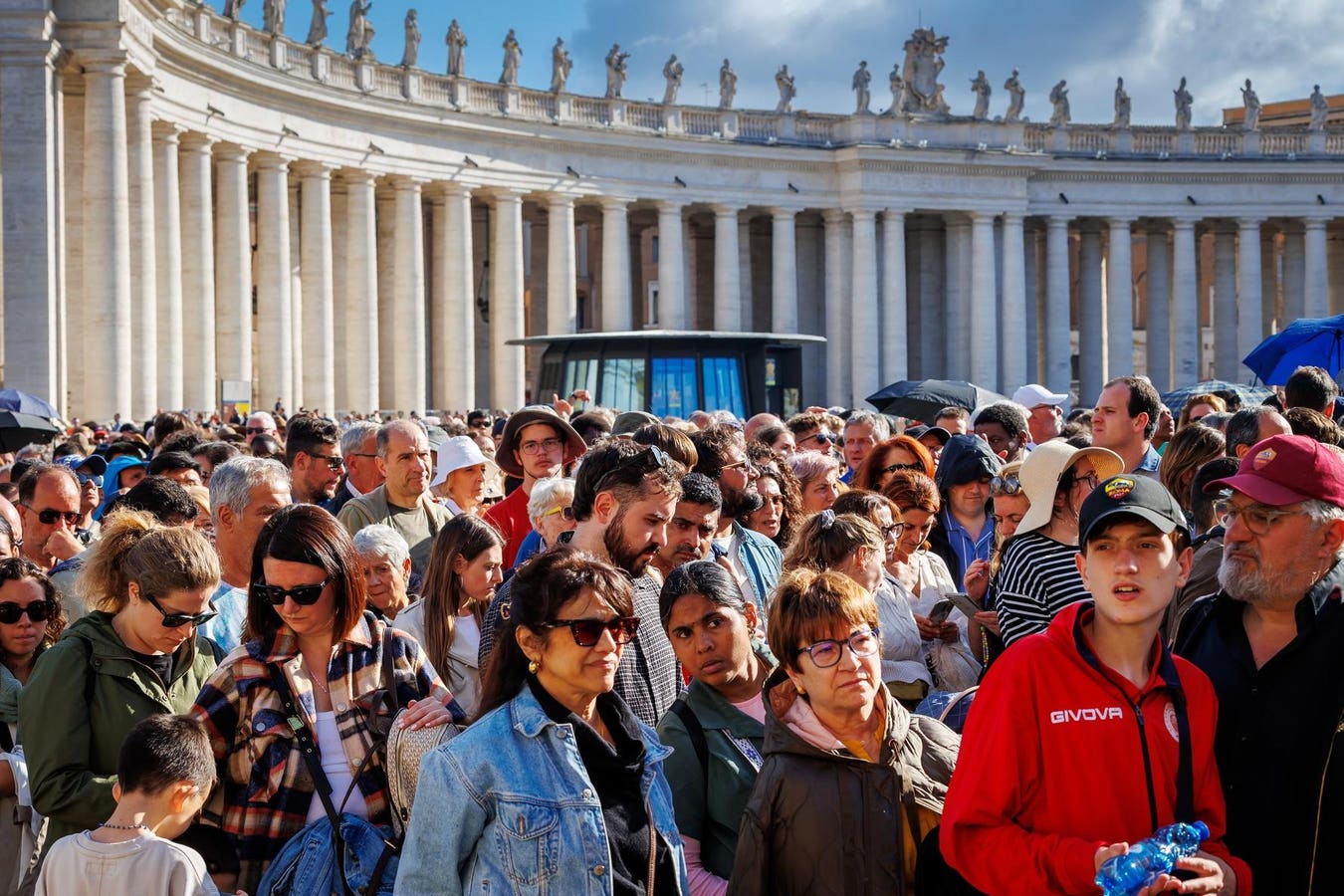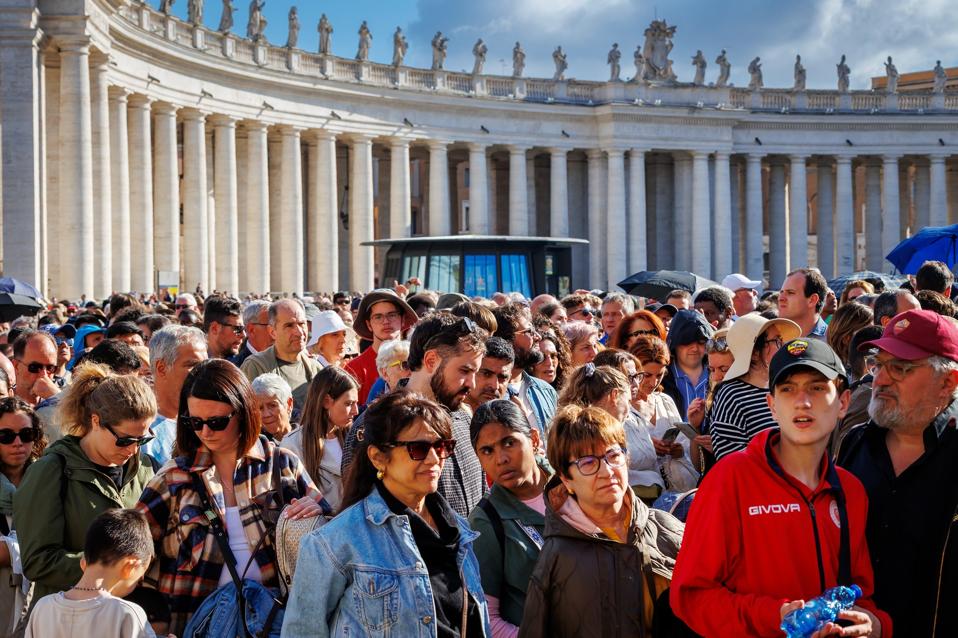Crowds of visitors line up to enter St. Peter’s Basilica. in Vatican City, Rome.
getty
From monuments and sites such as the Louvre Museum in Paris and the Trevi Fountain in Rome, islands including Santorini and the main Canary islands, to cities large and small like Spain’s Barcelona, Italy’s Venice, Croatia’s Dubrovnik and Belgium’s Bruges, the lists of European destinations impacted by overtourism grow every year.
Along with that growth are massive protests of increasingly frustrated and angry residents tired of record crowds,, noise, overwhelmed services, impossible housing costs, traffic congestion that threat their way of life. Posters inviting visitors to “Go Home” and even cases of physical attacks against tourists like in Barcelona and Valencia this summer where protesters shot water guns to unsuspecting tourists are not rare. Anti-tourism movements are starting to have an effect on local elections.
The fear of an “Overtourism Crisis” in Europe with the surging in the numbers of travellers coming to the old continent this summer is real and forcing governments to address the environmental, social and economic pressures it is creating.
During the first quarter of 2025, there were 452.4 million overnight stays in tourist accommodations across the EU, according a European Commission’s Eurostat analysis.
Last year, 747 million international travellers visited the continent, far outnumbering any other region in the world, according to the U.N.’s World Tourism Barometer.
Crowds of tourists outside entrance to Edinburgh Castle, Edinburgh, Scotland, United Kingdom.
getty
Some countries carry heavier loads than others. France, the biggest international destination, last year received 100 million international visitors, while second-place Spain received almost 94 million — nearly double its own population.
Visiting many of the most popular sites in Europe has become a physical ordeal where after long lines people are pushed through by the masses trying to take selfies.
ForbesSpiritual Tourism: 8 Iconic European Pilgrimage Routes And Ancient TrailsBy Cecilia Rodriguez
“Europe, often dubbed the world’s museum, is grappling with an unprecedented surge in tourism, transforming its picturesque streets into crowded thoroughfares and sparking widespread ‘overtourism concerns,” writes The Independent. ’The continent’s record-breaking visitor numbers are now straining local resources and sparking a backlash from residents as the familiar sight of suitcases rattling on cobblestones and selfie-snappers jostling for position has become a symbol of the strain.”
A view of the Trevi Fountain in Rome, Italy on May 10, 2025. Photo by Jakub Porzycki
NurPhoto via Getty Images
Cruise ships, bringing thousands of visitors to locations already overwhelmed by overtourism like Venice, the Canary and Balearic islands, Santorini and other small Greece islands, leave a significant ecological impact while contribute little to the local economy.
Foreign visitors accounted for approximately 45.6% of all overnight stays in the first 3 months of 2025, as per the Eurostat report. What is new is the large differences among EU countries, with the smallest ones like Malta (91.2%), Cyprus (85.7%) and Luxembourg (80.4%) getting the biggest share of foreign overnight stays, above the “usual suspects” like Spain, France and Italy.
The first places of the top most overcrowded tourist destinations in the world — measured by the number of visitors (taken from tourism figures from national tourist boards and reports), outnumbering the local population by a lot ,- in a new ranking by Go2Africa highlighting the growing global trend.
Although, as explained by The Mirror in an article titled ‘Do not travel zones where tourists overwhelm locals’, “the ratio of visitors to locals does not tell the complete story of a destination and its relationship with tourism, it gives a good indication of how reliant a place’s economy is on tourism and how busy it’s likely to feel during peak season.”
The long queue of visitors to enter the Versailles, Chateau in France, a UNESCO World Heritage, long queue of visitors
getty
Vatican City Tops Overtourism Ranking
In # 1 with the most disproportionate tourist per local ratio is Vatican City, the world’s smallest country in area and population. A sovereign city-state located within Rome it is just 0.44 square kmts. in size and a place of pilgrimage and cultural significance for many people around the world.
With just 882 residents the Vatican welcomes a staggering 6.8 million tourists a year which equates to 7,710 visitors for every local.
“Every day thousands of visitors are literally pushed through this Vatican cash machine by the museum’s guardians,” writes a visitor in Tripadvisor about the experience at the Vatican Museum. “Practically no chance to quietly admire the various masterpieces.”
Statistics from last May show that the number of visitors at the Vatican can reach 25,000 per day with massive ticket lines often snaking around the walls. That’s more than 1/2 million visitors per month.
In second and third place are also other European micro-countries.
Locals and visitors in the capital of Andorra.
getty
Principality Of Andorra Second In The List
The principality of Andorra a land-locked small country of 468 square kms, 2 and ½ times the size of Washington D.C, located between France and Spain takes second place.
With a population of over 85,000 people -by a 2023 census-, this small European country best known for its luxury ski resorts and tax-free shopping, receives around 9.6 million tourists per year. This equates to a ratio of 118 tourists per resident.
The status of the tiny principality as a tax haven and the fact that it is almost entirely geared towards tourism, contribute to its outsized appeal.
Nestled in Pyrenees, Andorra also offers stunning landscapes with peaks over 2,000 metres high, deep valleys and winding rivers.
Aerial view of San Marino old town with Italy behind in horizon
getty
Tiny San Marino And Overtourism
The third country in the list, where visitors outnumber the local population is another mountainous landlocked microstate in Southern Europe: San Marino.
Surrounded in all sides Italy and founded in 301 AD, it is the world’s oldest surviving republic, maintaining its independence for over 1,700 years. A UNESCO World Heritage Site it boasts three imposing fortresses on surrounding towering peaks.
The capital, also called San Marino is located in the slopes of Monte Titano and its known for its medieval walled old town and narrow cobblestone streets. Visitors are drawn to the landscape, cuisine and architectural sights.
Over 60 kilometres squared, it’s the third smallest territory in Europe and the fifth smallest in the world.
With only 33,600 residents San Marino attracts 2 million tourists per year which equates to a ratio of 60 tourists per local.
At the same time that San Marino appears among the destinations with locals being outnumbered by visitors, it is frequently mentioned in rankings of the l’east visited countries in Europe.’
Crowds of Tourists waiting for the Changing of Guards at the Prince’s Palace Of Monaco.
getty
Has Monaco An Overtourism Problem?
Another principality, Monaco, a sovereign microstate on the Mediterranean Sea’s French Riviera, not far from the Italian region of Liguria, attracts luxury travelers to its famous casinos, yachts, and Mediterranean coastline and the city-state is often packed with visitors.
Monaco gets around 340,000 tourists per year.
If, according to the local Monaco Voice, “Monaco seems to have avoided the pitfalls of mass tourism,” it still appears in #8 of the list of places where visitors outnumber the local population.
The principality occupies an area of 2.08 square kms, making it the second-smallest sovereign state in the world, after Vatican City.
Its population of 39,000 makes it the most densely populated sovereign state. Only around 10,000 residents are Monégasque nationals.
Monaco also has a record for the world’s shortest national coastline of 3.83 km, not counting landlocked nations and it is recognised as one of the wealthiest and most expensive places in the world.
Overhead of the imperilled by overtourism, Blue Lagoon in Comino, Malta.
getty
Malta’s Dangerous Overtourism
“Malta named as ninth most overcrowded tourist destination worldwide” is the title of the Malta Independent about the new report.
With a history going back seven thousand years Malta, located between Sicily and the northern coast of Africa, is renowned for its sun-drenched beaches, ancient ruins, and vibrant Mediterranean culture.
Last year, Malta had a registered population of 563,443 people and over 3.5 million tourists which equates to 6.32 tourists per resident.
The Malta Business Weekly reports that the country already has already received “a bit over 1.4 million tourists in the first five months of 2025, which normally constitutes around 35% of all tourists for the year. It seems ever more likely that we will get more than 4 million (possibly 4.1 million) tourists in 2025. Last year we had 3.6 million tourists. From 2019 we have increased tourist arrivals by 54%, but real income from tourism has increased by 51%.”
In the summer months, Malta’s residents have to put up with crowds of tourists, especially young people arriving in low fare flights and cruise passengers, which has raised alarm from environmentalists and local residents of an “environmental collapse.”
The growth in tourist numbers is particularly affecting one of its most iconic, photographed and fragil sites, the Comino Island’s Crystal Blue Lagoon, which according to local reports, has reached a tourism breaking point with over 10,000 visitors from across the world per day.
A beautiful 1.4-square-mile natural pool with crystal-clear waters and striking limestone formations, the Cristal Blue lagoon has been transformed from a once tranquil place for swimming and snorkeling, into an overcrowded area full with boats and sunbathers during peak season, resulting in a growing imbalance between the polluting tourism and environmental sustainability of rare bird habitats and protected marine zones.
This is how the BBC describe the situation at the Comino’s Cristal Blue Lagoon: “shoulder-to-shoulder crowds jostle for space, litter spills from overflowing bins and tangles in trampled rock rose shrubs, while gas-guzzling powerboats blast music and leave behind a trail of environmental damage.
Frustration over Comino’s overtourism has been growing for years, with some disillusioned visitors going as far as to call the day-trip experience from Malta a “scam” and overcrowded boats, limited amenities and worsening environmental degradation have led to mounting pressure on authorities to act.”
MORE FROM FORBESForbes12 Beautiful Winners Of The U.N. World Oceans Day Photo CompetitionBy Cecilia RodriguezForbesWorld Naked Bike Ride: A Protest Against ‘Indecent Exposure’ To Car CultureBy Cecilia RodriguezForbesThe 10 Best Hidden Places In Europe For 2025, Per New EBD ReportBy Cecilia Rodriguez

